Almost 14 Years In The Making And It Is Just The Beginning.
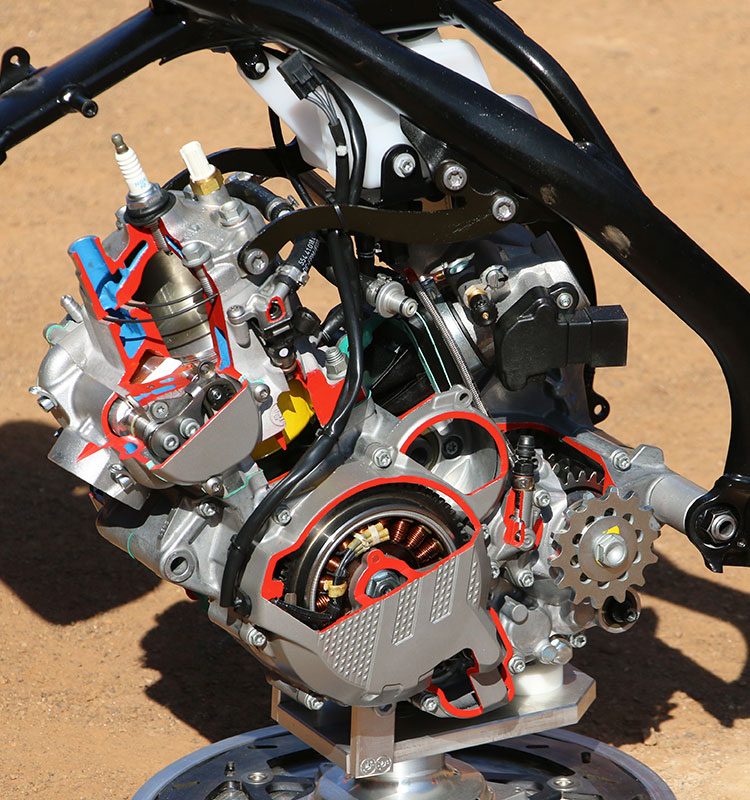
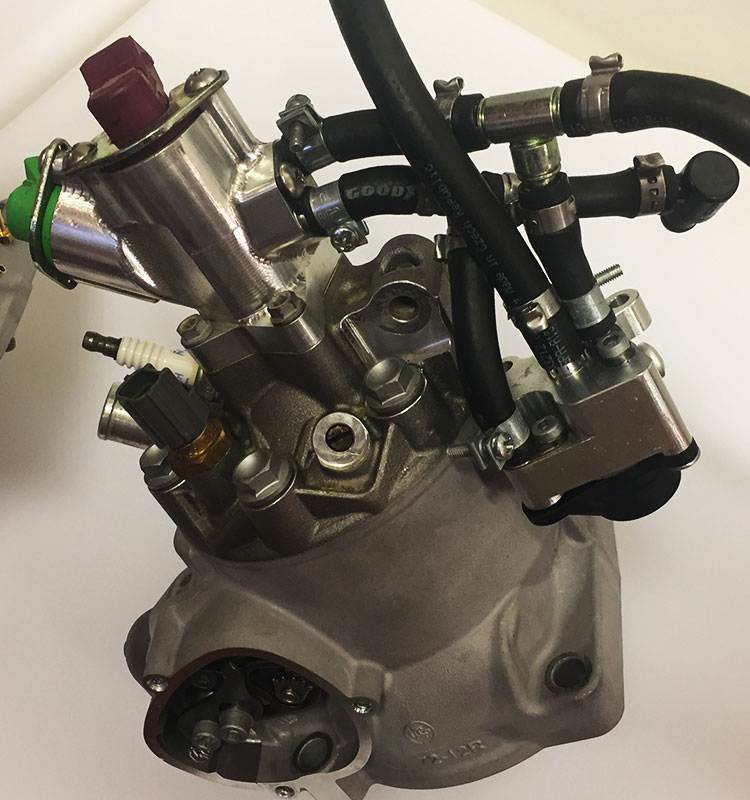
Most were very surprised when KTM revealed that they had been working on a replacement for the carburetor since 2004. But any forward-looking company would be doing this. With impending emissions regulations coming and the entire automotive industry going in this direction, it was not a matter of if, but when? The outright advantage of a two-stroke engine design, in off-road motorcycle applications has been simplicity. In 2004 nothing could be more simplistic than a carburetor, but FI was coming, like it or not.
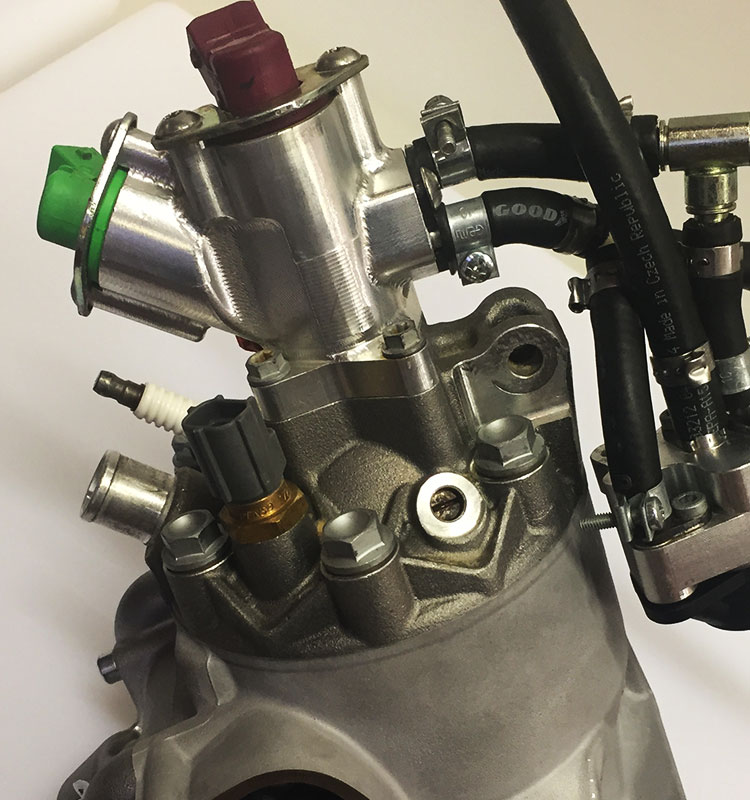
In the early stages KTM chose a slightly different route. They predicted that Direct Injection would be the right path for the two-stroke, more from an emissions standpoint. Emissions was the sole driving force at this time and again even now from KTM’s view. Direct injection is shooting the fuel into a closed combustion chamber after the piston had closed off the exhaust port. That way there was no excess unburnt fuel getting into the exhaust and in doing so making the exhaust gasses “dirty”. At the time a company called Orbital was the leader in direct injection. It had successfully implemented its technology for direct injection onto outboard boat engines and had even begun to work on snow mobile applications. KTM chose to work with Orbital using its technology. The hardware part of the equation was simple in design yet difficult to apply to a lightweight and compact motorcycle chassis. And even bigger problems loomed in the software side where a machine that had such a wide power spread over a big RPM range that included lower and higher RPM than was needed in other applications. The computers were not fast enough, or at least not at the cost level they would need to be for production. Even running this in test applications the performance was said to be pretty bad. Pumping all that fuel and air into the head of such a small space and constrained engine was proving to be a challenge. Before anything really got going all resources were going towards four-stroke FI so this project was put on the back burner.
An interesting side note is that one of the very senior KTM R&D guys, a die-hard two-stroke rider himself, said that if the first DI system was implemented he would have switched to four-strokes. Maybe a good sign as the core rider was speaking from the inside. That having to do with the DI system and the changes to the chassis to make it all work properly. The power required to run the high-pressure pumps and the need to pressurize the air charge to be mixed with the fuel presented design constraints that were anything but simple.
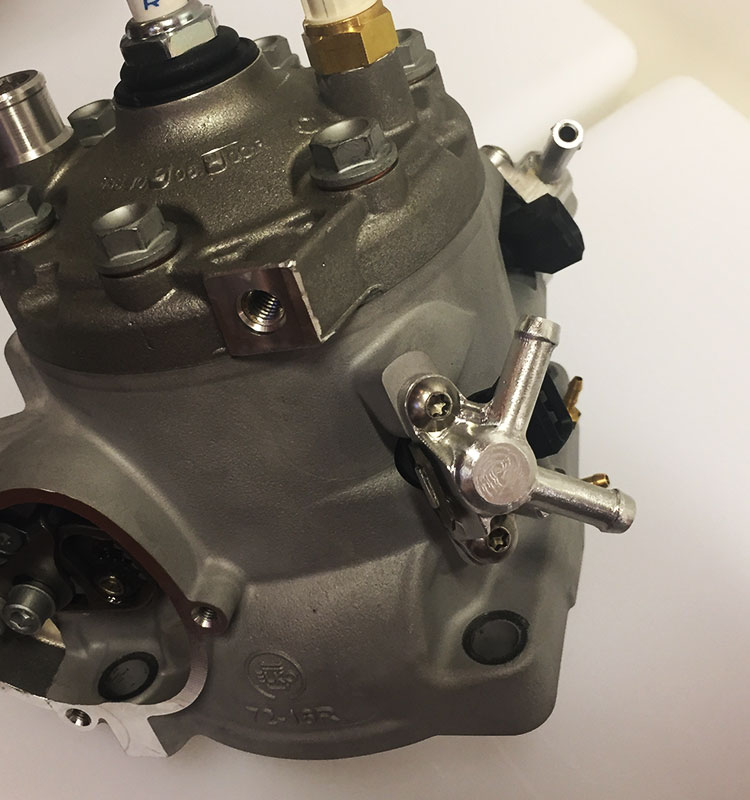
The next stab at the problem was attacked by utilizing a lot more computer modeling and simulation. There had been little development in the production of two-stroke non-carbureted applications but many companies were working on it internally in and around 2010. Though FI was now commonplace on four-stroke and seeing performance advantages, some unique problems were preventing a simple adaptation to the two-stroke. Nor was there a company with off-the-shelf parts to place on a two-stroke.
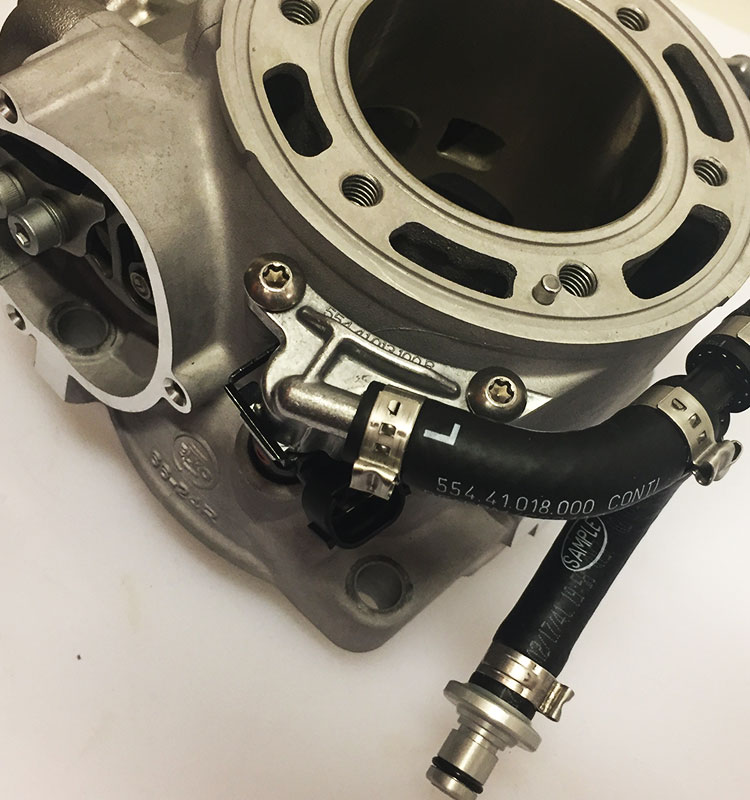
KTM was still looking at a direct injection of fuel and air into the cylinder as the answer. Now using a low pressure direct injection system to deliver the fuel into the cylinder with conventional delivery of the air through the reed valve controlled intake tract. The low pressure DI system would actually inject while the exhaust was still partially open where less pressure was needed. Here the key to the TPI system was realized and in essence the key to getting a digitally controlled fuel into the combustion chamber. The closer you can put the delivery point where the metering takes place in relation to the combustion chamber the better. But you also have to time it and have the proper amounts so that it isn’t dirty and still makes power. Faster computers and better aiming of the fuel was played with. The basic theories of two-stroke tuning were not seeming to change based on what method the fuel was delivered. Using the expansion chamber to basically supercharge the combustion chamber with sonic waves was still going to be the norm, for now. But in all the testing and development of the DI system, KTM says that they never achieved the performance of the carburetor. It was still a little complex requiring more power to run the fuel pumps and obviously some more issues they were not willing to disclose. We suspect they are still working on it as future emissions regulations with tougher standards will require an even more clean burn in the future and direct injection is seen as the only answer for a two-cycle engine design without some sort of mechanism to completely close the exhaust port.
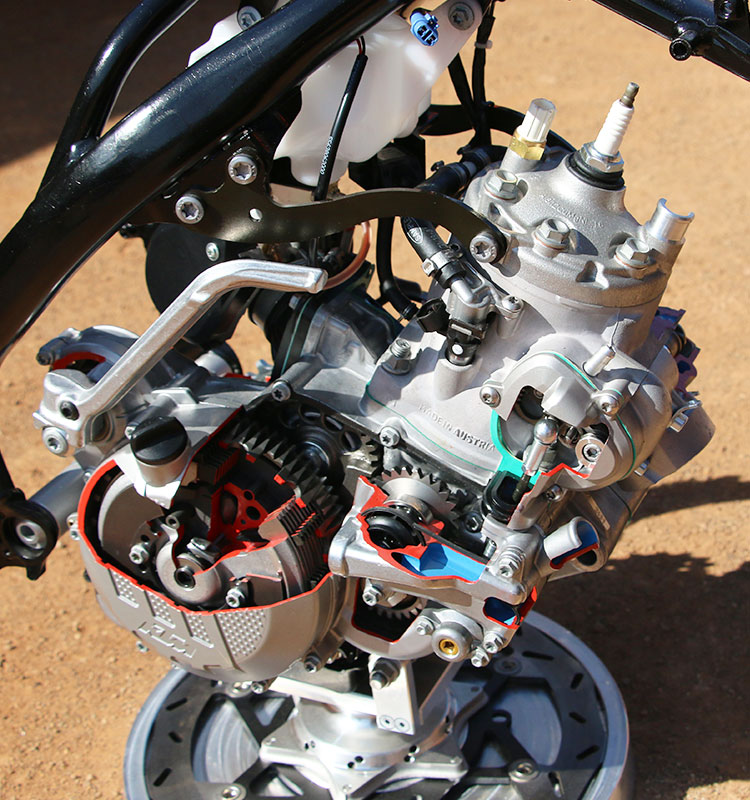
Yet somehow not too long ago, less than two years we are told, there was the switch to the fuel injection model. It was using a lot of standard type parts like the injectors and sensors from the four-stroke bikes, as well as the in-tank fuel pump and filters. An oil injection system, necessity for clean emissions was already in use so that would be even easier. For sure the software would need to be all-new but KTM had a great location of the injectors in the rear transfer ports which would be very key going forward. Shooting fuel in here is about as close to the combustion chamber as possible but also as far away from the exhaust port as possible. This allows the fuel now mixing with the oil/air mixture to get into the combustion chamber, stay there and fill up–then also get bounced back by the return wave inside the exhaust while the exhaust port is still open. KTM showed journalists some of the engine modeling and how this whole two-stroke thing works, it was obvious by the long faces and confused looks in the room some were very perplexed.
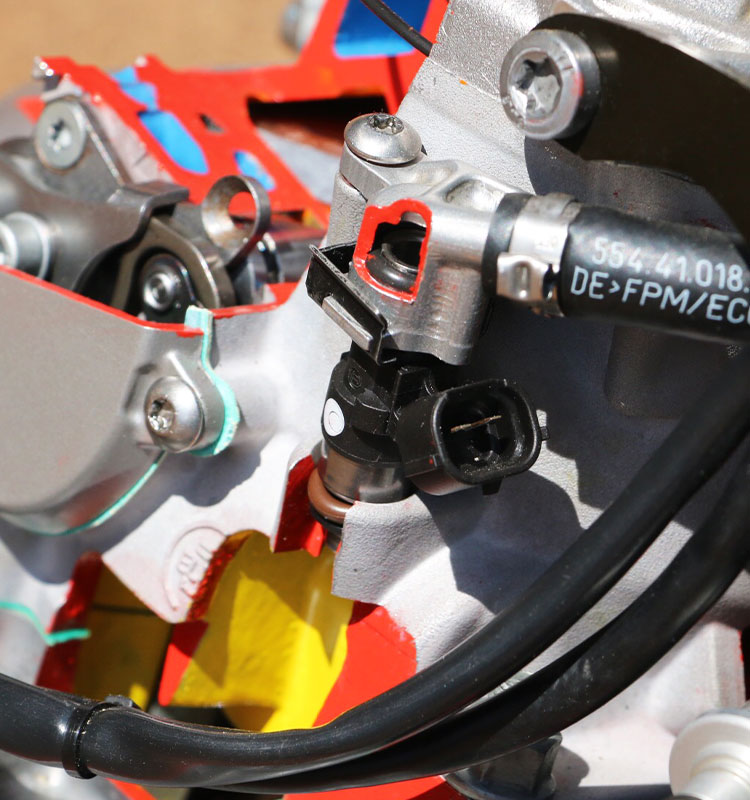
Now using accepted and understood parts it all came down to processing the information and getting the mixtures right. Quickly. The window of time for the injector to be open and getting the large amount of fuel a two-stroke needs is the challenge, especially in even smaller displacements we are told. Plus when a two-stroke has a “flame-out” inside the combustion chamber, it can take up to 50 strokes for the engine to recover. This was a big issue in high RPM, low throttle times. For instance when you are going down a hill with the engine revving and then you give it a little gas. Making the throttle response as good as that antiquated carburetor was very difficult. There is not a lot of time for the computer to decide how much fuel and when to shoot it from one stroke to the next since the conditions inside the two-stroke engine can change drastically and very suddenly. Even small things like having the engine’s crankcase pressure sensor and fuel injectors mounted so that vibration was not affecting them were lessons learned in testing. Luckily the new 2017 engine was designed from the beginning to eventually have a non-carbureted fuel system so it would vibrate less and also be able to produce as much electrical power as would be needed.
The goal of having an FI system that performed as good as a carburetor and on a bike that was considered “Ready To Race” was a pretty big challenge. In the end the answer, for now, was actually quite simple. In partnership with Synerjet the ECU was developed and tuned and that has been the difficult part in getting a base system to work off of. Now more tuning and testing can take place to see where FI will go on two-strokes. Further testing and the release to the public later this year will show if the advantages outweigh any disadvantages. Will the ability of the system to compensate for altitude and temperature without needing jets and its fuel efficiency outweigh any cost increases or yet to be seen durability issues. The first riding impressions revealed excellent “jetting feeling” but with a very smooth and controlled throttle response that was said to be tuned as such. So it will be with other models adaptation (or not) like the SX and US XC two-strokes to see if FI can deliver the aggressive power delivery these bikes need. The same was true in the early progression on four-strokes and we have always felt it was the engineers tuning more than test riders. Because the power that regular riders claim they want isn’t what always makes sense.
The future for alternate fuel delivery in two-strokes is just beginning and in fact nothing new. What will come rather quickly as these technologies advance is a whole evolution of enhancements in the designs to make the most of the expanding potential. There hasn’t been anything this radical since the exhaust powervalve in two-strokes and before that a digital ignition. I still remember speaking to the late Eyvind Boyesen telling me about a 60 horsepower 125cc two-stroke engine concept design he had come up with. And somehow even then, likely 10 years ago, I believed he was seriously telling the truth. If you think about it the carburetor is actually the plug (or restrictor) that is holding up the progression of the two-stroke. But in all of this it may have to go away from being so simple.
We’ll let Motocross Action tell you even more with this very pretty video, listen carefully as usual, they tell all:
Want to keep DBT doing stories like these without ads popping up all over the place? Shop through links below to support us:


4 Responses to “Two-Stroke Fuel Injection: KTM’s Path To TPI”
ETicket55 .
Great article … thanks. I completely understand how the fuel injection/timing is handled … but am still confused on how the oil is injected/managed. Just have to wait for the next level of tech reveal?
Jimmy Lewis
Computer determines the amount and it is pumped into the throttle body where it mixes with the air. It is based on throttle position and RPM, just like the system on the Betas.
Matteo
Will oil “mix” (nebulize) well only with air? This is my only concern in this engine. I’ve seen the bike last week, and for what I could see, the oil just drop (not high pressure injected) after the throttle body
Jimmy Lewis
Having a little gas in that air makes little difference and oil injection has been around a long time. It obviously works as we saw no motor failures at the intro and the bikes were used hard.